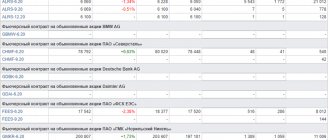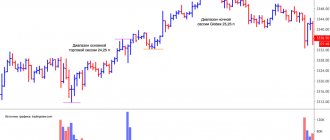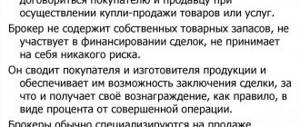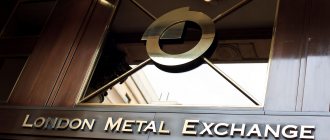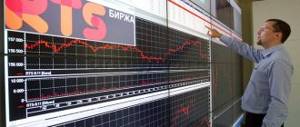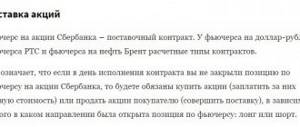List of futures on MICEX
| Underlying asset | Contract codes | Futures type (settled/delivered) |
| For promotions | ||
| Aeroflot | AFLT | Delivery |
| Alrosa | ALRS | — |
| Severstal | CHMF | — |
| FGC UES | FEES | — |
| Norilsk Nickel | GMKR | — |
| Gazprom | GAZR | — |
| RusHydro | HYDR | — |
| Lukoil | LKOH | — |
| Magnitogorsk Iron and Steel Works | MAGN | — |
| Moscow Exchange | MOEX | — |
| Magnet | MGNT | — |
| MTS | MTSI | — |
| Novatek | NOTK | — |
| NLMK | NLMK | — |
| Pole | PLZL | — |
| Rosneft | ROSN | — |
| Rostelecom | RTKM | — |
| Surgutneftegaz prev.(*) | SNGR | — |
| Sberbank | SBRF | — |
| Sberbank priv. | SBPR | — |
| Transneft priv. | TRNF | — |
| Tatneft | TATN | — |
| VTB Bank | VTBR | — |
| BMW AG | GBMW | Calculated |
| Deutsche Bank AG | GDBK | — |
| Daimler AG | GDAI | — |
| Volkswagen AG | GVW3 | — |
| On the S&P500 index of American stocks | ||
| S&P500 | U500 | — |
| Product items | ||
| For oil grade Light Sweet Crude Oil | C.L. | — |
| For Brent oil grade | BR | — |
| Gold | GOLD | — |
| Silver | SILV | — |
| Platinum | PLT | — |
| Palladium | PLD | — |
| Aluminum | ALMN | — |
| Zinc | Zn | — |
| Nickel | NI | — |
| Copper | Co | — |
| Raw sugar | SUGR | |
| Gold | GLD | Delivery |
| Silver | SLV | — |
| Indexes | ||
| RTS | RTS | Calculated |
| Moscow Exchange | MIX | — |
| Moscow Exchange (mini) | MXI | — |
| Moscow Exchange blue chips | RTSS | — |
| Volatility of the Russian market | RVI | — |
| Currency pair rates | ||
| US dollar ($)/Ruble | Si | — |
| Euro/Ruble | Eu | — |
| Euro/$ | ED | — |
| Australian dollar/$ | AUDU | — |
| $/Japanese yen | UJPY | — |
| $/Swiss franc | UCHF | — |
| $/Canadian dollar | UCAD | — |
| Pound sterling/$ | GBPU | — |
| $/Turkish lira | UTRY | — |
| $/Indian Rupee | UINR | — |
| $/Ukrainian hryvnia | UUAH | — |
| Yuan/Ruble | C.Y. | — |
| On interest rates | ||
| RUSFAR | 1MFR | — |
| One-day loans RUONIA | RUON | — |
| MosPrime | MOPR | — |
| OFZ futures | ||
| 2 year olds | OFZ2 | Delivery |
| 10 year olds | OF10 | — |
| 15 year olds | OF15 | — |
| 6 year olds | OFZ6 | — |
| 4 year olds | OFZ4 | — |
(*) Privileged. The rest default to common shares.
In trading terminals of the Moscow Exchange, the futures expiration date is added to the contract code. Example AFLT-12.19. Expiration in December 2021.
Futures online
This page provides a chart that allows you to track futures online. No special software installation is required; the graphs are displayed in the browser and updated automatically. Typically, freely available futures charts are provided with a data delay of 10 minutes or more. To get around this limitation and view futures online, you can use the corresponding CFDs, the dynamics of which coincide with futures, and the data is provided without any delay or restrictions. There is a difference in absolute values between the underlying futures and its CFD derivative, but it remains at the same level with identical asset dynamics. This method allows you to track futures online, getting an idea of the dynamics of the instrument without delays.
Using this chart, you can track both futures (with a slight delay) and the corresponding CFDs on the underlying contracts (in real time). To view the futures you are interested in online, you need to start entering the name of the instrument in the appropriate field above the chart. Attention! Tickers may differ from the usual designation; a list of tickers for futures and CFDs of the most popular instruments is given in the table below the chart.
- Agriculture
- Energy
- Equity Index
- FX
- Interest Rate
- Metals
| tool | futures* | CFD |
| Cocoa | CC1! and CC2! | |
| Coffee | KC1! and KC2! | |
| Corn | ZC1! and ZC2! | |
| Cotton | CT1! and CT2! | |
| Lean Hogs | HE1! and HE2! | |
| Live Cattle | LE1! and LE2! | |
| Soybean Meal | ZM1! and ZM2! | |
| Soybean Oil | ZL1! and ZL2! | |
| Soybeans | ZS1! and ZS2! | |
| Sugar No 11 | SB1! and SB2! | |
| Wheat | ZW1! and ZW2! |
| tool | futures* | CFD |
| Crude Oil Brent | CB1! and CB2! | UKOIL |
| Crude Oil WTI | CL1! and CL2! | USOIL |
| Natural Gas (Henry Hub) | NG1! and NG2! | NGAS |
| tool | futures* | CFD |
| DAX Index (FDAX) | DY1! and DY2! | GER30 |
| EURO STOXX 50 (FESX) | FX1! and FX2! | EUSTX50 |
| E-mini Dow (DJIA) | YM1! and YM2! | |
| E-mini NASDAQ 100 | NQ1! and NQ2! | NAS100 |
| E-mini S&P 500 | ES1! and ES2! | SPX500 |
| tool | futures* | CFD |
| Australian Dollar (AUD/USD) | A61! and A62! | AUD/USD |
| British Pound (GBP/USD) | B61! and B62! | GBPUSD |
| Canadian Dollar (CAD/USD) | D61! and D62! | |
| Euro FX (EUR/USD) | E61! and E62! | EURUSD |
| Japanese Yen (JPY/USD) | J61! and J62! | |
| New Zealand Dollar (NZD/USD) | N61! and N62! | NZDUSD |
| Swiss Franc (CHF/USD) | S61! and S62! | |
| US Dollar Index | DX1! and DX2! |
| tool | futures* | CFD |
| T-Bond (US Treasury Bond) | ZB1! and ZB2! | |
| 10-Year T-Note (10-Year US Treasury Note) | ZN1! and ZN2! | |
| 5-Year T-Note (5-Year US Treasury Note) | ZF1! and ZF2! | |
| Euro Bund (FGBL, 10-Year) | GG1! and GG2! | BUND |
| Euro Bobl (FGBM, 5-Year) | HR1! and HR2! | |
| Euro Schatz (FGBS, 2-Year) | HF1! and HF2! |
| tool | futures* | CFD |
| Copper | HG1! and HG2! | COPPER |
| Gold | GC1! and GC2! | XAUUSD |
| Palladium | PA1! and PA2! | XPDUSD |
| Silver | SI1! and SI2! | XAGUSD |
*In the “futures” column there is a universal ticker for displaying the instrument chart: 1! at the end it will show the nearest contract, 2! — the next contract after the nearest one. If you want to select a contract for a specific month, then you should enter the name of the instrument and select the desired one from the drop-down list.
The table shows only a portion of the available futures. If the required instrument is not listed, you can find it by entering its name in the appropriate field at the top of the chart.
When entering characters in the search box, you can select the type of tool
When searching by instrument name, we recommend typing the full name. For example, to view the AUD/USD futures chart, you need to enter Australian Dollar. When you enter a name, a menu divided into categories also becomes available, which can make searching easier.
This chart allows you not only to view futures online, but also to conduct a full technical analysis of the instrument. You can read more about using the settings and analytical elements of the chart at the bottom of the page with charts for US stocks - American stocks.
What is a futures and why is it needed?
Synonym - derivative instrument. Or a derivative. The parties agree on the price and timing of implementation. The underlying asset acts as a settlement instrument. At its core, a futures contract is a bet on a future price.
The buyer and seller know that Gazprom shares cost 250 rubles in November. Both agree that in December they may cost more - 255 rubles. In accordance with the specification, 1 Gazprom futures = 100 shares. The parties shook hands, the transaction price was 25,500 rubles. for futures.
The underlying asset can be anything. Securities, commodities, currencies, indices, weather, etc. The exchange determines the types of futures for trading. On the Moscow Exchange, the underlying assets are stocks, oil, metals, sugar, indices, currency pairs, interest rates, and OFZ.
Futures can be settlement and delivery:
- Settlement - at the time of termination of the futures, settlements between the parties are made in money, regardless of the nature of the underlying asset. The moment of final settlement between the parties (expiration) is expiration.
- A deliverable futures contract implies mandatory delivery of the underlying asset under the terms of the specifications of the futures contract.
Example: the Moscow Exchange has settlement and delivery futures for gold.
Used for speculation, insurance of exchange risks (hedging), supply of real goods in the case of a deliverable futures contract.
The essence of stock indices
Now let's talk in more detail about the stock market, its indices, as well as what quotes for securities and other financial instruments are.
An index is an indicator from which one can understand the change in the exchange rate of a security on a certain date. In practice, this is usually a complex criterion for pricing the entire group of securities that make up the index basket. There are a large number of indices, ranging from regional to sectoral.
Dynamic index values are taken as a basis in order to understand in which direction a particular market is moving. Index names most often use a number that indicates how many shares of different companies are taken into account when calculating it. I will give examples of the most famous indexes (I am sure that you have come across some of them):
- Dow Jones
- Nasdaq 100
- Standard & Poor's 500
- Nikkei
- FTSE
- CAC 40
- DAX 30
- SSEC
How to trade futures on the Moscow Exchange
Choose a reliable broker, enter into a brokerage service agreement with him, transfer money to a trading account and install a trading terminal to work with the Moscow Exchange. When concluding an agreement, mark the FORTS site for working with it. As a rule, a single account is provided from which trading operations are carried out on the derivatives and stock markets.
After installing the trading program, create a table with the derivatives market instruments that you plan to trade. Plus other tables for working with FORTS.
Main futures indices of Russia
Russia is represented by one large stock exchange – MOEX (Moscow Exchange). Its key indices are IMOEX, RTS, MOEXBC.
Speculators are often interested in the Russian market and its index futures because their earnings are based on market volatility rather than growth expectations. Experts have many complaints and questions about the leading Russian exchange. Read the informative article “Moscow Exchange MOEX on Negative Reviews of Masterforex-V”, in particular, the section “Why do classical investment techniques not work on MOEX?”
The most popular among investors and traders on the Russian market is futures on the RTS index, traded on the FORTS derivatives market. This is a key indicator of the Russian stock market.
The RTS index futures chart shows a strong drop towards the end of 2014 – beginning of 2015 and a gradual recovery of lost positions by the end of 2021.
Futures on the MSCI Russia index from Euronext are also known.
Russia is a country with rich natural resources. It has URALS oil, gas, coal, aluminum, uranium, gold, developed electricity production, large harvests of wheat, barley, corn... The prospects for the development of the stock market, and accordingly the growth in the popularity of Russian stock indices and futures on them, are very good. The potential for Russians to enter financial markets is high. If in the USA every second citizen invests in the stock market, in the Russian Federation this figure is still much lower - only 1.5%.
In 2021, Russia's GDP was $1.6 trillion. Peak figure: $2.3 trillion. was achieved in 2013.
Trading strategy for beginners
I will consider the “shock day” strategy on the stock exchange.
Price movement in one direction without strong pullbacks. For simplicity, I will consider the price movement upward. The price increase during a trading session on the exchange (main and additional) can reach 3-10%. Less often - more. During the 2008 crisis, on some days the prices of blue chips reached tens of percent.
How to determine whether the day will be a shock one or not? Signs of a shock day:
- positive opening, often with a gap. Gap - price opening with a gap relative to the previous close. Example - the price closed at a price of 100, the opening the next day was 100.5. Gap 0.5%.
- informational occasion. Allows us to assume a rise in prices on the stock exchange. This could be a company report, or any sharply positive news for the instrument. For example, the recent unexpected sharp decline in oil production as a result of a drone attack in Saudi Arabia caused prices to rise by more than 10%. The market reacts immediately.
A shock day may not necessarily start with the beginning of the trading session. More often it happens differently - when information comes out that affects quotes.
Let me consider an example of just such a day - May 14, 2021. Gazprom shares. Futures completely repeat the dynamics of the underlying asset. Japanese candlesticks, timeframe 15 minutes.
The beginning and end of the main trading session on the Moscow Exchange is limited by vertical red lines (10.00-18.45 Moscow time). Each candle is 15 minutes. Since the beginning of the session there was sluggish trading at the same level. Gazprom opened the day on the stock exchange at a price of 163 rubles. After 15:30, the Moscow Exchange releases positive news about a change in the company's dividend policy.
A new accrual scheme and an increased amount of payments for the current period upward. The market responded with an explosive rise in prices. From 163.03 to 178 in the first 15 minutes. This is 100% a reason for a shock day. You need to open a long position right away. Over the remaining 3 hours, quotes went to 189.67. Price increase by 18%.
Forecast
This derivative may be threatened by cataclysms that shake the fundamentals of global financial markets. But such events occur very rarely, after which the markets recover. Therefore, investing in Nasdaq 100 futures is very promising for making a profit.
General characteristics and features of the underlying asset
The Nasdaq 100 Index includes companies in the technology and biotechnology sectors. These are fast-growing industries that keep pace with modern scientific and technological advances. Therefore, the index reflects the state of not only finance, but also science and technology.
The index does not include shares of financial companies. This allows Nasdaq 100 futures to be less dependent on financial fluctuations.
Analysis and influencing factors
Economic growth and technological development allow the Nasdaq index to outperform other American stock indicators. Considering the strength and size of the American economy, its stability, the percentage growth of the high-tech sector is, although less than Chinese GDP, but much more reliable. Commodity and financial factors have an indirect effect; the index is not so sensitive to price fluctuations on other exchanges in the world.
Example deal
After the Nasdaq 100 futures fell, it was necessary to wait for a reversal upward and enter before the price made a breakthrough. This was done at 7786. Then, after waiting for growth after the gap (gap on the chart), a decision was made to exit at a price of 7834. The basis for exit was the accumulation of profit + the fact that the gap usually closes.
Where and from whom to learn trading
Ways to learn trading on the stock exchange.
Firstly, from your broker. Leading companies all provide training in various formats for beginners and experienced traders.
An example is the Otkrytie training programs. In-person, remote, webinars, demo trading. On the website, select the appropriate option.
Another example is the training programs of the BCS broker.
Secondly, programs and websites of private traders. Various forms of part-time and part-time education. Seminars, webinars, etc.
Examples:
- website of the famous trader Alexander Rezvyakov;
- training programs by Dmitry Cheryomushkin. Website https://dctrading.ru/;
- trading school of Dmitry Mikhnov.
Major futures indices in Asia
Asia is another region of contrasts. Here, poor, rich and developing countries coexist. For example, China is the second largest economy in the world (but about this country and its futures indices in a separate section).
Key Asian stock exchanges (excluding PRC): BSE (Bombay), NSE (National Stock Exchange of India), KLSE (Malaysia), TWSE (Taiwan), KRX (Korea), HOSE (Ho Chi Minh City Stock Exchange), TSE (Tokyo), SGX (Singapore), PSE (Philippines) and SET (Thailand).
It is interesting that the largest Asian stock exchange is not Chinese, but Japanese - TSE (3rd place in the world ranking). However, experts have more complaints about the Japanese market than about the Chinese one - “Why is the influence of the Tokyo Stock Exchange falling in the financial world?”
Key Asian stock market indices:
- BSE SENSEX 30, NIFTY 50, NIFTY Next 50, NIFTY 100 – India,
- FTSE Bursa Malaysia KLCI – Malaysia,
- TAIEX – Taiwan,
- KOSPI, KOSDAQ – South Korea,
- VN Index – Vietnam,
- NIKKEI 225, TOPIX Core 30 – Japan,
- STI - Singapore,
- PSEi – Philippines,
- SET – Thailand.
Advice from Prof. futures traders
Some tips for trading futures on the Moscow Exchange:
- Make a trading plan before opening futures. Preferably on paper.
- Determine the amount of possible loss. Place a stop order on the futures in accordance with the plan and the acceptable amount of losses.
The technology of working with futures allows the use of borrowed funds. It is enough to provide a guarantee. The size and rules of use are determined by the Moscow Exchange and the broker. It may change depending on the situation.
An example is an increase in GO during holidays and during strong movements. If there is insufficient collateral, the broker may forcefully close the client’s open futures at a loss to the latter. This should always be remembered when using borrowed money.
The best solution is to open a futures contract for a portion or size of a trading account. If the market goes in the right direction, add borrowed money. In this case, the average price of the position will be lower than the market price (if long). This is what you should focus on when placing stop orders.
This reduces the risk of losses. If the price has moved in the desired direction by more than 3%, you should focus on setting a stop in the amount of 2% below the average price of the position. In the most negative scenario, such a stop is unlikely to be disrupted by “market noise”; there will be no losses. The trader will remain with his own.
Why index futures are attractive to investors
Savvy investors prefer index futures contracts for two main reasons:
Easy to perform preliminary analysis. It is easier to track information for an individual industry than to analyze the financial performance of individual issuers. Based on the general trend towards diversification through multi-discipline, it is quite difficult to analyze issuers.- You can work with such a financial instrument continuously. When a trader works in the stock market, the attractiveness of the stock or futures index on that stock that he uses as a trading instrument decreases if the company goes bankrupt.
In such a situation, a player has to choose a new financial instrument, collect all the necessary information about it and develop a new trading strategy.
When using a futures index, this problem does not arise, since the bankruptcy of one company will not greatly affect the overall value of the contract. Trading strategies for the stock exchange using index futures are the most stable.
Major Australian futures indices
Australia is a country with rich resources, which the government wisely manages, improving the standard of living of the local population. Australia's GDP is $1.32 trillion. (2017), GDP per capita is about $50 thousand - one of the highest indicators in the world.
The key stock exchange is the ASX. Let’s also note our neighbors – the New Zealand stock market NZX.
Key indices:
- S&P/NZX 10, S&P/NZX 50 – New Zealand,
- S&P/ASX 200, S&P/ASX 20 – Australia.
Rating of CFD brokers for futures indices
Traders and investors have the opportunity to trade CFDs through authorized brokers. To help avoid mistakes, especially for beginners, the Masterforex-V Academy compiles a rating of CFD brokers, dividing them into recommended ones - very reliable, and others with many mixed ratings.
| Broker name | Year of foundation | CFD | Licenses | |
| 1. | NordFX | 2008 | commodity futures, stock indices, cryptocurrencies, shares | CySEC, MiFID |
| 2. | Swissquote | 1996 | commodity futures, stock index futures, cryptocurrencies, metals, ETFs, warrants, shares | FINMA, FCA, SFC, Dubai FSA |
| 3. | Dukascopy | 1998 | stock indices, commodity futures, stocks, bonds, ETFs | FINMA, FCMC |
| 4. | Alpari | 1998 | metals, energy, indices, cryptocurrencies | — |
| 5. | FxPro | 2006 | indices, commodity futures, stocks | FCA, CySEC, FSB, Dubai FSA, BaFin, ACPR, CNMV |
| 6. | Interactive Brokers | 1977 | stocks, bonds, derivatives, forward contracts, bills, warrants, options, stock indices, currency and commodity futures | NFA, CFTC, FCA, IIROC |
| 7. | Oanda | 1996 | bonds, stock indices, commodity futures | NFA, CFTC, FCA, IIROC, MAS, ASIC |
| 8. | FXCM | 1999 | stock indices, commodity futures, cryptocurrencies | FCA, BaFin, ACPR, AMF, Dubai FSA,SFC, ISA, ASIC, FSB |
| 9. | Saxo Bank | 1992 | currency and commodity futures, stock indices, ETFs, stocks, bonds, derivatives | Danish FSA, Consob, Czech National Bank, Bank of the Netherlands, ASIC, Monetary Authority of Singapore, FINMA, Bank of France, Central Bank of the UAE, Japanese Financial Services Agency, Securities and Futures Commission in Hong Kong. |
| 10. | FOREX.com | 1999 | stocks, stock indices, commodity futures, cryptocurrencies | NFA, CFTC, FCA, ASIC, JSDA, MAS, SFC |
| 11. | FIBO Group | 1998 | metals, energy, commodities, cryptocurrencies, indices | CySEC |
Brokerage companies that cannot yet be recommended by the Academy due to numerous claims against them:
| Broker name | Year of foundation | CFD | Licenses | |
| 1. | Forex Club | 1997 | indices, commodities, shares, ETFs | — |
| 2. | TeleTrade | 1994 | commodities, indices, shares | — |
| 3. | ActivTrades | 2001 | indices, commodities, stocks, bonds, ETFs, cryptocurrencies, options | FCA, SCB |
| 4. | FreshForex (Fresh Forex) | 2004 | indices, commodities, stocks | — |
| 5. | eToro (eToro) | 2007 | indices, commodities, stocks, ETFs, cryptocurrencies | ASIC, FCA, CySEC |
| 6. | FortFS | 2010 | currency futures, indices, commodities, bonds, stocks, cryptocurrencies, ETFs | IFSC Belize |
| 7. | BCS Forex (BCS Forex) | 2004 | stocks, indices, commodities | — |
| 8. | NPBFX (Nefteprombank) | 2016 | goods, cryptocurrencies | — |
| 9. | Admiral Markets | 2001 | cryptocurrencies, commodities, stocks, ETFs, indices, bonds | ASIC, FCA, EFSA, CySEC |
| 10. | Grand Capital (Grand Capital) | 2006 | stocks, indices, commodities, cryptocurrencies | FinaCom |
| 11. | RoboForex (Roboforex) | 2009 | indices, commodities, stocks, cryptocurrencies | CySEC, IFSC Belize |
| 12. | FXOpen | 2005 | indices, commodities, cryptocurrencies | FCA |
| 13. | Forex Optimum Group Limited | 2009 | indices, commodities, stocks | — |
| 14. | EXNESS | 2008 | goods, cryptocurrencies | FSA Seychelles |
| 15. | Forex4you (Forex fo you) | 2007 | stocks, indices, commodities, cryptocurrencies | FSC BVI |
| 16. | LiteForex | 2005 | stocks, commodities, indices | CySEC, MiFID |
| 17. | MaxiMarkets (Maximarkets) | 2008 | stocks, commodities, indices | — |
| 18. | xDirect | 2002 | indices, commodities, bonds, cryptocurrencies | VFSC Vanuatu |
| 19. | 2011 | indices, commodities, stocks | ASIC, IFSC, CySEC | |
| 20. | Larson&Holz | 2004 | promotions, goods | — |
| 21. | FXTM | 2011 | stocks, commodities, cryptocurrencies, indices | CySEC, FSCA South Africa, FCA |
| 22. | GKFX | 2009 | indices, goods | FCA, JFCA, DMCC, BaFin, AMF, AFM, CONSOB, CNMV, , CNB, NBS |
| 23. | HYCM | 1989 | indices, commodities, stocks, cryptocurrencies | FCA, CySEC, CIMA, DFSA |
| 24. | TurboForex | 2010 | goods, indices | — |
| 25. | FinmaxFX | 2018 | stocks, bonds, commodities | NAFD, VFSC Vanuatu |
| 26. | InstaForex (InstaForex) | 2007 | stocks, commodities, indices, cryptocurrencies | FSC BVI |
| 27. | DF Markets | 2010 | indices, commodities, cryptocurrencies, ETFs | |
| 28. | AMarkets | 2007 | stocks, indices, commodities, cryptocurrencies, bonds | |
| 29. | Weltrade | 2006 | goods, cryptocurrencies | |
| 30. | World Forex | 2007 | stocks, indices, commodities, cryptocurrencies | |
| 31. | Key to Markets | 2010 | stocks, commodities, indices, cryptocurrencies | |
| 32. | Pepperstone | 2010 | stocks, indices, commodities, cryptocurrencies, ETFs | |
| 33. | IC Markets | 2007 | indices, commodities, stocks, bonds, currency futures, cryptocurrencies | |
| 34. | PROFIT Group | 2001 | stocks, commodities, indices, cryptocurrencies | |
| 35. | IG Markets | 2000 g | indices, commodities, options, bonds, cryptocurrencies, ETFs | |
| 36. | ForexStart | 2007 | stocks, commodities, indices | |
| 37. | iFOREX | 1996 | stocks, commodities, indices, cryptocurrencies, ETFs | |
| 38. | StreamForex | 2012 | goods | |
| 39. | CapTrader | 1997 | stocks, commodities, indices, bonds, derivatives, forward contracts, warrants, options | |
| 40. | AxiTrader | 2007 | commodities, indices, cryptocurrencies | |
| 41. | EasyMarkets | 2003 | stocks, commodities, indices, cryptocurrencies | |
| 42. | Kalita Finance (Kalita Finance) | 1999 | stocks, commodities, indices, cryptocurrencies | |
| 43. | HotForex | 2009 | stocks, indices, bonds, commodities, cryptocurrencies | |
| 44. | IFC Markets | 2006 | indices, commodities, stocks, cryptocurrencies, ETFs | |
| 45. | Xtreamforex | 2015 | indices, commodities, stocks, cryptocurrencies | |
| 46. | 770capital | 2000 g | stocks, commodities, indices, cryptocurrencies | |
| 47. | AMEGA | 2000 g | goods, cryptocurrencies | |
| 48. | ForexChief | 2000 g | indices, commodities, cryptocurrencies | |
| 49. | FP Markets | 2000 g | stocks, commodities, cryptocurrencies, indices | |
| 50. | Gerchik & Co | 2000 g | stocks, commodities, cryptocurrencies, indices | |
| 51. | SimpleFX | 2000 g | stocks, commodities, indices, cryptocurrencies | |
| 52. | AvaTrade | 2006 | cryptocurrencies, stocks, options, indices, ETFs, commodities | |
| 53. | STForex | 2014 | indices, commodities, stocks, cryptocurrencies | |
| 54. | Renesource Capital | 1998 | stocks, commodities, indices, bonds, derivatives, forward contracts, warrants, options | |
| 55. | Tickmill | 2011 | indices, commodities, bonds | |
| 56. | E-XUN Asia Company Limited | 2017 | goods | |
| 57. | BlackBull Markets | 2000 g | indices, goods | |
| 58. | FTM Brokers | 2000 g | indices, goods | |
| 59. | HQBroker | 2000 g | stocks, commodities, indices | |
| 60. | Tradershome | 2000 g | stocks, commodities, indices, cryptocurrencies | |
| 61. | Esplanade Market Solutions | 2014 | stocks, commodities, indices | |
| 62. | IronFX | 2010 | commodities, indices, stocks, currency futures | |
| 63. | MTrading | 2014 | promotions, goods |
If you would like to learn more about their activities, learn about the tools they offer and the nature of the claims, please follow the hyperlinks provided.
Major African futures indices
Africa is the poorest region in the world. On this continent there are countries with the lowest GDP and standard of living, but they are adjacent to wealthier countries - South Africa (the only representative of Africa in the G20), Egypt, Morocco.
In all of Africa, there is one large stock exchange - the JSE (Johannesburg), which ranks 18th in the world ranking. Its key index is JTOPI, the popular futures index is South Africa TOP-40.
